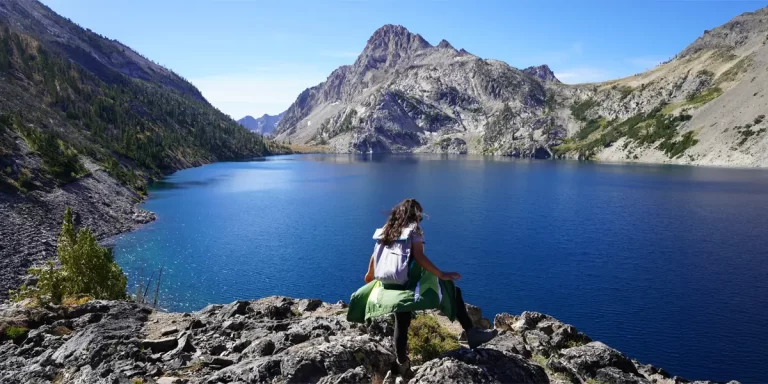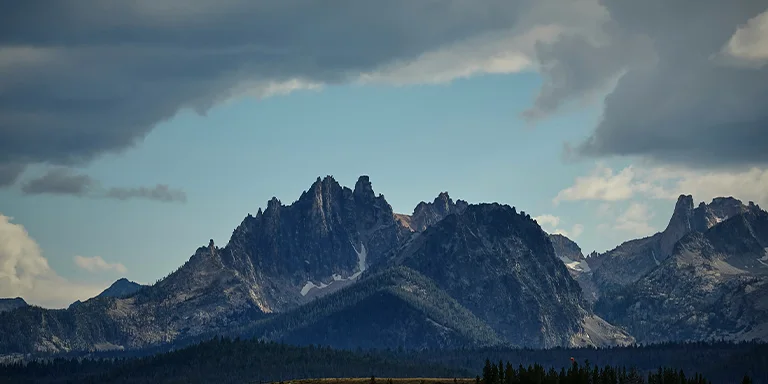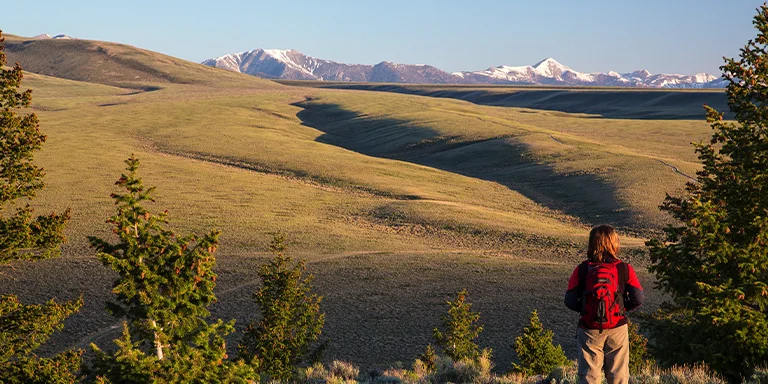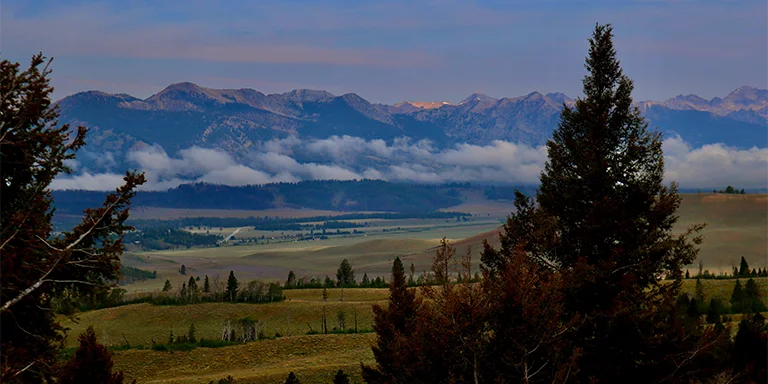

Backpacking in Idaho offers immense variety for outdoor enthusiasts, from the storied Sawtooth Mountains to windswept high deserts, including popular destinations like the Frank Church Wilderness.
And that’s what this post is all about – backpacking in Idaho. We’ll provide tips to help you prepare for backpacking in this diverse state as well as showcase the TOP 5 multi-day trails in Idaho.
Interested? Let’s get started planning an epic Idaho backpacking trip!
Discover the most stunning long trails in Idaho for amazing adventures:

Length: 67.6 mi / 108.8 km
Type: Loop
Difficulty: Hard
Elevation Gain: 12831 ft / 3911 m
Location: Sawtooth Wilderness Area
Estimated Hiking Calorie Burn: ~11500 calories
More Details: See on AllTrails.
This challenging 67.6-mile loop trail near Lowman, Idaho takes experienced backpackers 4 days to complete. The scenic route is popular for backpacking, birding, and camping from June to September. Dogs allowed on leash. Get a permit at the Grandjean trailhead. Well-maintained trail with mild temps, easy water crossings, and few bugs in September. Stunning mountain scenery makes the demanding mileage worth it. Start early each day and be prepared for rain.

Photo by Bob Wick, BLM via CC BY 2.0
Length: 27.9 mi / 44.9 km
Type: Loop
Difficulty: Hard
Elevation Gain: 6548 ft / 1996 m
Location: Nez Perce National Forest
Estimated Hiking Calorie Burn: ~5400 calories
More Details: See on AllTrails
This challenging 27.9-mile loop near Riggins, Idaho takes experienced backpackers 2-3 days to complete. Best from July to September, the scenic trail allows dogs on leash. Expect solitude, few people encountered. Diverse scenery from lush meadows to burned forests. Stunning views of Hells Canyon along ridge. Relatively flat with some steep sections. Pristine backcountry lakes for swimming and fishing. Varying trail conditions with some deadfall – bring map. Camp at beautiful lakes like Baldy, Echo, Sheep. Clockwise preferred for gentler second day. An incredible but demanding loop showcasing Idaho’s rugged wilderness.

Length: 73.6 mi / 118.4 km
Type: Loop
Difficulty: Hard
Elevation Gain: 16279 ft / 4962 m
Location: Sawtooth Wilderness Area
Estimated Hiking Calorie Burn: ~13530 calories
More Details: See on AllTrails.
This very challenging 73.6-mile loop near Lowman takes experienced backpackers over 3 days to complete. Popular July-August for backpacking and camping with some solitude. Stunning alpine lakes and valleys but beware difficult snow conditions at high elevations. Varying trail conditions – buried at times under snow. Prepare for difficult water crossings like Redfish Creek. The Imogene to Baron section is a highlight. Lake swimming provides relief from grueling miles. Overall an incredible loop with rewarding vistas despite tough mileage. Come prepared to be tested but awestruck by Idaho’s soaring peaks and pristine wilderness.

Length: 32 mi / 51.5 km
Type: Loop
Difficulty: Hard
Elevation Gain: 7122 ft / 2171 m
Location: Sawtooth National Recreation Area
Estimated Hiking Calorie Burn: ~5500 calories
More Details: See on AllTrails
This challenging 32-mile loop near Stanley takes experienced backpackers 3+ days to complete. Popular July-September for backpacking and camping with some solitude. Stunning alpine lakes and waterfalls. Varying trail conditions – some difficult creek crossings. The section from Sand Mountain Pass to Decker Creek is demanding but rewarding. Camp at pristine lakes like Edna, Imogene and Middle Cramer. Consider the boat shuttle across Redfish Lake to save time/energy. Follow Leave No Trace principles – no fires allowed. Prepare for quick weather changes in the high country. An incredible loop showcasing the majestic Sawtooth Mountains if you come prepared for the difficult mileage and terrain.

Length: 37.3 mi / 60 km
Type: Point to point
Difficulty: Hard
Elevation Gain: 9783 ft / 2982 m
Location: Sun Valley
Estimated Hiking Calorie Burn: ~6580 calories
More Details: See on AllTrails
This challenging 37.3-mile trail near Sun Valley is often hiked over 2 days. Offers solitude and scenic mountain vistas. Route of the grueling Standhope ultramarathon crossing rugged terrain. Highlight is Goat Lake with wolverine sightings possible. Expect an arduous trek covering substantial mileage and elevation, but few crowds and breathtaking high alpine scenery make it rewarding. Come prepared for a strenuous mountain adventure on this Sun Valley backcountry trail.
Idaho’s weather varies across its seasons:
In spring (March-May), expect daytime highs of 60-70°F, with lows around 30-40°F. Variable conditions include sun, clouds, and occasional snow showers, with wildflowers blooming at lower elevations.
Summer (June-August) brings hot, sunny days (80-90°F) and possible afternoon thunderstorms, especially at higher elevations.
Fall (September-November) sees highs of 60-75°F, cool, clear days, and changing aspen colors at higher elevations.
Winter (December-February) offers average highs of 30-40°F, with snow common, making backcountry skiing/snowshoeing possible.
Before making your gear selection, take a look at the weather statistics for Idaho (Boise):
| Jan | Feb | Mar | Apr | May | Jun | Jul | Aug | Sep | Oct | Nov | Dec | |
|---|---|---|---|---|---|---|---|---|---|---|---|---|
| High °F | 38 | 45 | 55 | 64 | 72 | 82 | 92 | 90 | 80 | 65 | 49 | 38 |
| Low °F | 25 | 30 | 36 | 41 | 48 | 55 | 62 | 61 | 52 | 43 | 33 | 25 |
| Rain/Snow (D*) | 7 | 6 | 7 | 6 | 6 | 3 | 1 | 2 | 3 | 4 | 8 | 8 |
Not sure if Idaho is right for you?
Don’t forget to check out our backpacking guides for Oregon and Montana.
Campfires are limited when backpacking in Idaho. Many wilderness areas don’t allow fires, but in other places, you can only have them in designated backcountry sites or existing fire rings. Use portable stoves instead of campfires because of the risk of fires. In dry conditions, fires might be completely banned.
When backpacking in Idaho, be ready for isolation, wildlife, and sudden weather shifts. Bring maps, a compass, GPS, and satellite devices to stay on track in remote areas. Pack extra food, water, warm clothes, and emergency shelter just in case. Always hike with a buddy or a group and let someone know your plans. Look out for signs of bears, mountain lions, and rattlesnakes, and know how to stay safe. Check the weather and trail conditions before you go and turn back if there are storms. Follow rules about campfires, campsites, and food storage to avoid fines or conflicts with animals. Be cautious near cliffs and on rocky slopes.
Be careful if you run into wildlife while backpacking in Idaho. Make noise on the trail to avoid surprising bears or mountain lions. Give them plenty of space and don’t get too close for photos. Look out for signs like tracks, scat, and rubs. Know how to use bear spray if needed. With bears, avoid eye contact, back away slowly, and talk calmly. If a mountain lion acts aggressive, make yourself look big and loud. Don’t run, as that might make them chase you. Watch out for snakes, give them space, and be cautious where you step. Tell rangers about problematic wildlife. Travel in groups, store food properly, and be extra careful at dawn and dusk.
While not an absolute requirement, bear spray can provide inexpensive insurance and peace of mind when backpacking deep into Idaho’s rugged wilderness areas and national parks. Though negative bear encounters are rare with proper food storage, bear spray allows you to be prepared if needed when immersed in the natural beauty of Idaho’s backcountry. Use good judgment based on location and conditions to decide if carrying bear spray is a wise precautionary measure for your specific route and trek into nature.